Pharma & Healthcare
Learn the Proven Formula for Engaging your Audience through Pharma Content
Your customers expect you to provide valuable content, at the right time demonstrating value and mee...

Mar 2, 2023
8 min read
Pharma is undergoing unprecedented change. Technology advances like artificial intelligence (AI) and machine learning (ML), vendor solution platforms, and an influx of real-world data are part of the big pharma trends driving a digital skills revolution in the industry.
In the first two posts from our three-part series covering digital transformation in the pharma industry, we reviewed the most exciting pharma tech trends for 2023 and listed 5 specific examples of pharma digital disruption.
In this this post, we’ll focus on what's driving the digital skills revolution in the pharmaceutical industry, including the following topics:
Advances in medicine and technology have converged to create all-in-one healthcare ecosystems that, when they work, help streamline patient experiences and increase access to healthcare.
For pharma industry executives, understanding what advances and digital trends drive change on a global enterprise level—as opposed to just focusing on marketing and sales—is critical to innovating.
Compared to other industries, Pharma is undergoing transformation
that is accelerating at an unprecedented pace. Per Gartner's 2023 Healthcare & Life Sciences Predictions, there are five pharma industry trends shaping skills transformation.
These include:
Understanding the potential barriers and macro pharma trends that executives face when embracing, and leveraging, the above trends enables you to leverage the skills needed to overcome barriers to digital transformation.
Gartner's 2023 Healthcare & Life Sciences Predictions, outlines specifics around each of the above. Here’s a summary of their statistics-backed findings:
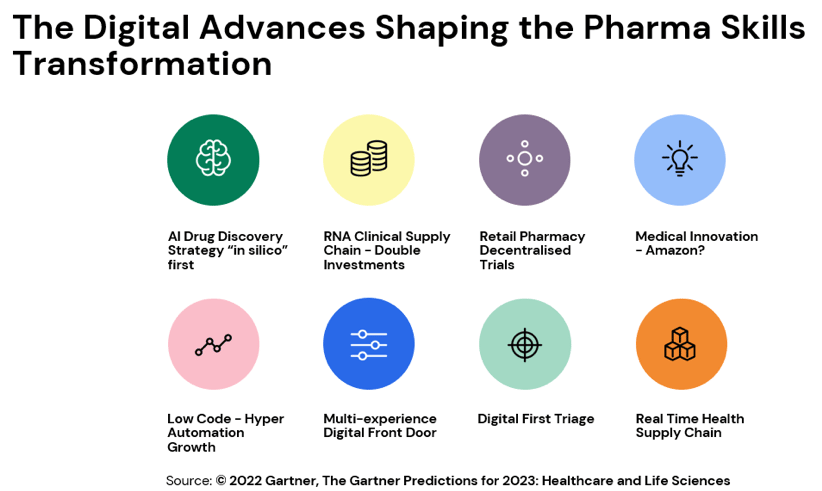
In healthcare, a digital front door is a strategy a provider and/or practice uses when engaging with a patient online. It considers the patient's online journey across a landscape of digital touchpoints, including the process the patient goes through before their intake and the tools they use to interact with their providers.
The following chart, gleaned from Gartner data, illustrates the digital front door in its entirety, from good health to clinical investigation/diagnosis to monitoring and care management.
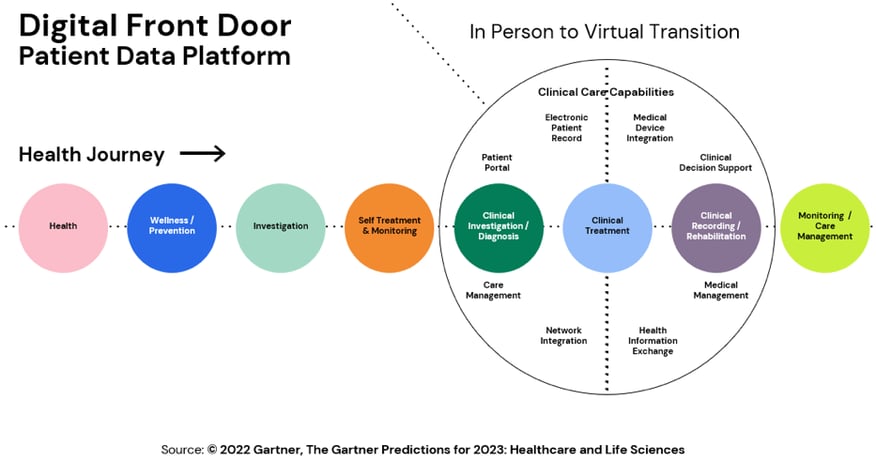
A digital front door strategy taps into the above patient trajectory by providing digital tools that minimize frustrations and facilitate communication during a patient's entire care journey.
The goal of a digital front door is to improve patient experiences and provide access to medical or mental health care. It often represents a health system's first point of contact with the patient. It includes features like online appointment scheduling, virtual visits, and telehealth services.
The digital front door is important because it allows healthcare providers to better engage with patients and provide more efficient—and effective—care.
Digital transformation is a neat way of describing something that's inherently messy. It is part of a collection of pharma trends that necessitate changing core elements of your business.
“COVID - 19 accelerated digital transformation in the Pharma and Healthcare industry by 75%” - Source: Statista 2022 / Pharmaceutical Technology Feb 2022 Median Acceleration 5 Years.
Successful digital transformation requires what Accenture calls a "high level of interoperability." It relies on connecting disparate systems and data, removing silos, and leveraging the cloud to function. It likely means you’ll need to make changes to more than one system and department, a phenomenon that Accenture calls “compressed transformation.”.
Companies with high interoperability are much more likely to succeed with compressed transformation initiatives. This kind of change requires buy-in from pharma leaders including managers, directors, and executives.
This requires three key contributions from executive leadership during the planning and execution of a successful digital transformation:
Interoperability is what enables an integrated digital ecosystem and this is the goal of digital transformation. It’s a shift that, when successful, enables and facilitates adaptability, agility, user experience, collaboration, and growth.
Covid-19 accelerated digital transformation across the pharma and healthcare sectors by 75%. So, while you're not alone in managing what amounts to monumental change in business as usual, you are faced with figuring out how to accomplish this change.
To this end, we've identified eight critical moves that pharma leaders must embrace to succeed with a successful digital transformation project.
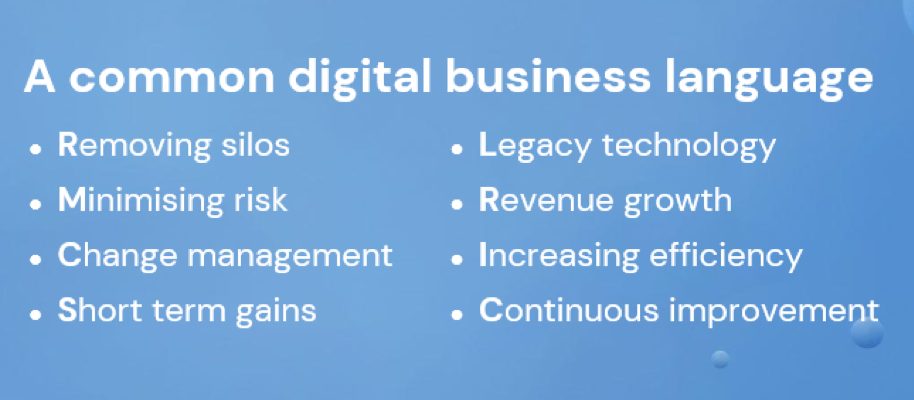
According to Accenture, a company that achieves a high level of interoperability today, stands to make $8 billion more over the next 5 years versus a comparable company that is less successful at digitalization.
According to Circus Street’s research, we’ve identified six must-have skills you need to successfully achieve integrated digital transformation, as follows:
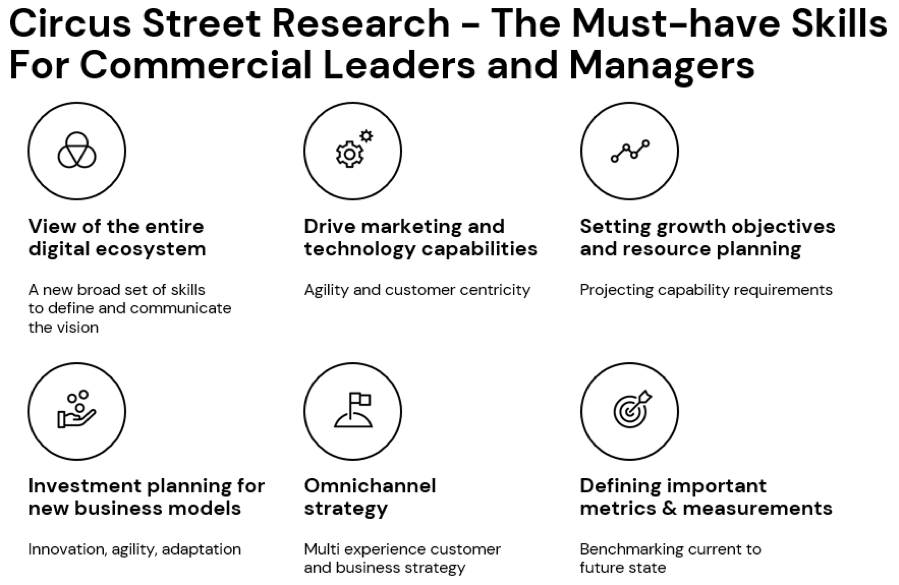
The required leadership contributions combined with the critical moves and must-have skills listed above work together to help leaders overcome commonly shared barriers which include:
To succeed at digital transformation and keep up with pharma industry trends, you need to communicate that a change initiative is about more than introducing new technology or processes. The focus is, rather, on improving customer experience. Upskilling will help employees embrace and understand a customer-centric approach.
It’s the only way to align your digital transformation strategy to your vision. It requires removing silos, connecting incentives to outcomes that support this strategy, and having full buy-in from executives.
A common roadblock to successful digital transformation is investing in the wrong technology or not fully leveraging the technology you have. All parts of your technology ecosystem need to work together or you risk investing in expensive tools and platforms that ultimately make the customer and employee experience worse.
Change can be hard, particularly when existing processes and approaches are effectively generating revenue. But avoiding digital transformation or tackling it in a piecemeal way, will set you up for failure in the long run. Legacy systems keep data and entire departments siloed off from larger organizational change, which makes it much more difficult to scale.
With any large digital transformation initiative, it’s important to set expectations right from the start. This is particularly important in pharma, a sector where new technologies and innovations are common. Make sure your entire team understands that change is the new constant and that it’s important to look at digital transformation as an ongoing process rather than a one-time fix.
The pace of change can be difficult to fully grasp, particularly in an industry like pharma where things once moved at a far slower pace. Per data from Cognizant, only about 3% of 32,000 clinical trials were digital or hybrid in 2019. Over the next four years, this is expected to rise to 25%, a staggering 800% increase.
6 years from now, the way pharma will take their products to market will have changed. If you started building your pharma company from scratch, you wouldn’t build it the way it is today.
There are some specific levers you should consider when undergoing digital transformation. Again, at the heart of this is interoperability so you can achieve an integrated digital ecosystem. The focus should be on removing silos and unifying your data, processes, and people so everyone is working together to achieve your organizational goals.
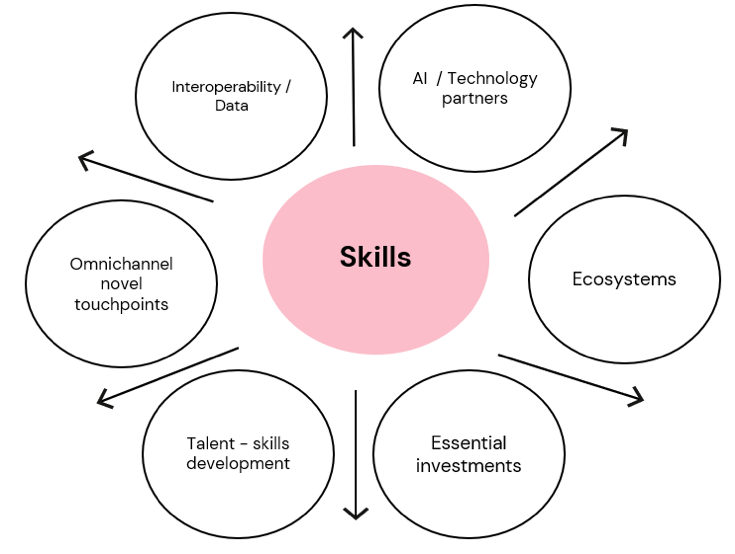
Interoperability/data - metrics that matter
Prioritize clinical solutions that include interoperability as a core feature, including APIs that facilitate the transfer of content and data between clinical sites, sponsors, clinical research organizations, and other ecosystem participants.
Prioritize omnichannel - novel touchpoints
Create a multi-experience environment with customers and consumers that moves away from disconnected healthcare provider (HCP) engagement strategies. That means developing novel touchpoints and facilitating personalized digital experiences that matter.
Talent - skills development
Employee experience and skills development are critical for digital transformation success. Future proofing demands that you create a skills-based organization focused on one vision and business imperative.
Essential investments
Invest in new revenue models using technologies as enablers for hyper-automation and innovation.
Ecosystems
New business models including as-a-service-models, digital front door solutions, and decentralized trials should be part of your digital transformation toolkit.
AI/technology partners
Work with AI and technology partners like drug discovery platforms and software companies that leverage AI and machine learning. Co-invest in that innovation because for a solution provider or startup, that is their entire business. They are motivated to be ahead of the curve, no matter what.
Upskilling your team helps clarify to them why digital transformation should be a business imperative. Training helps communicate this throughout the organization. It also helps those who may be slower to adopt change. This is where skills-based learning comes in.
There are three keys to unlock the application of what has been learnt in real day to day business functions.
Another example of innovative learning techniques is our Enterprise Wide Data Literacy Bootcamp. A blended learning journey that enables learning at the point of need whilst also having options for group activities, which promotes healthy discussions.
Recommend Reading: Learn about our pharma digital marketing course, Product Launch Campaigns for Pharma & Healthcare which includes three comprehensive lessons to help with digital planning and product launch, applying a customer-centric approach, and implementing a digital campaign roadmap.
Your customers expect you to provide valuable content, at the right time demonstrating value and mee...
Having had the privilege of contributing to many country, regional and global launches, as well as w...
Succeeding at digital transformation requires a dedication to change, particularly when it comes to ...
Get in touch and we can start helping with your digital learning journey.